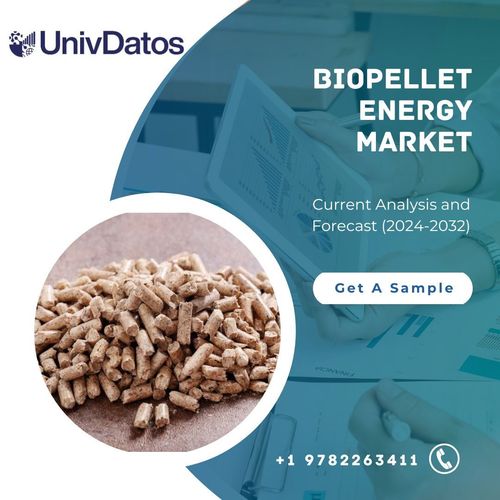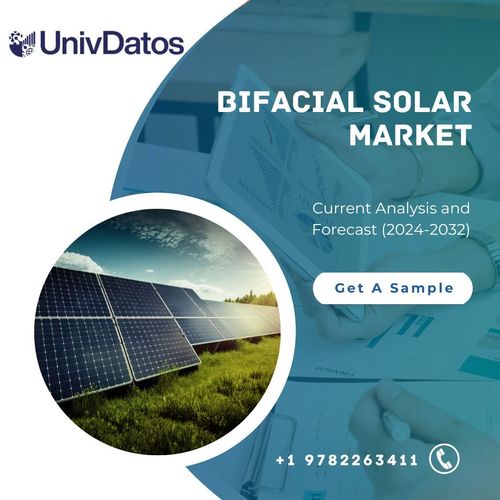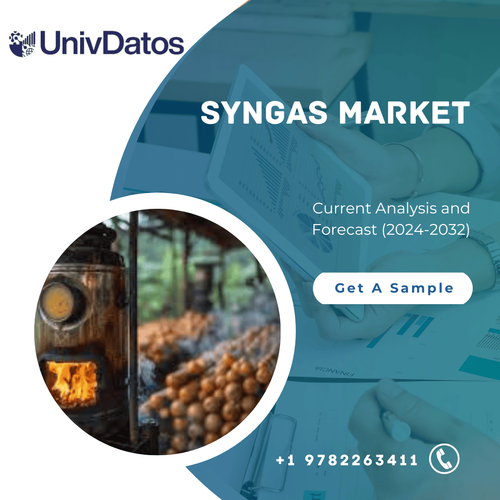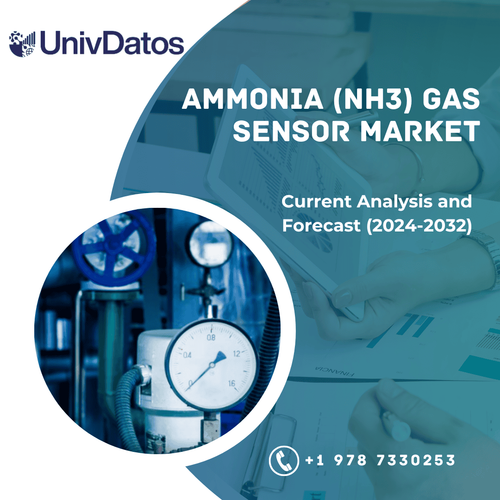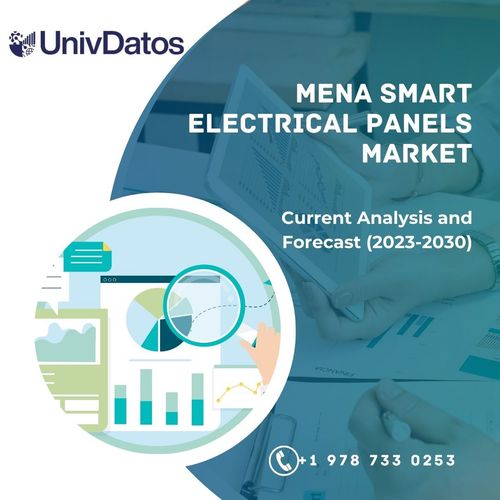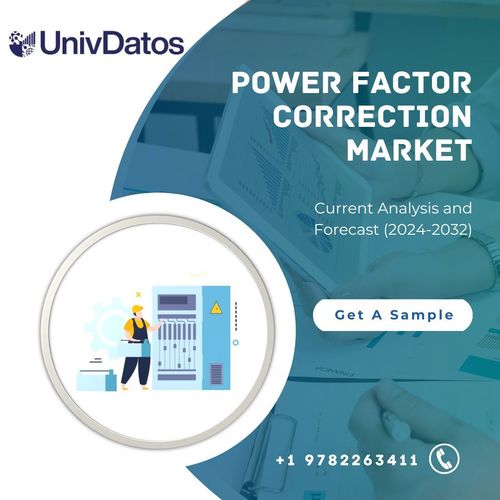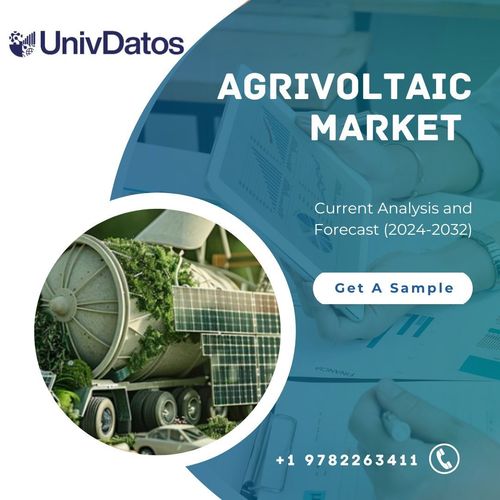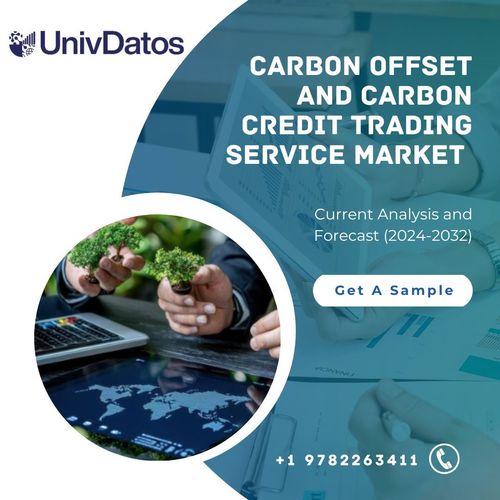Solar Encapsulation Market: Current Analysis and Forecast (2023-2030)
Emphasis on Technology (Thin Film, Multi-Crystalline Silicon, and Mono-Crystalline silicon); End-User (Residential, Commercial & Industrial and Utility-scale); Material (Ethylene Vinyl Acetate, Non-Ethylene Vinyl Acetate, UV Curable Resin, and Others); and Region/Country
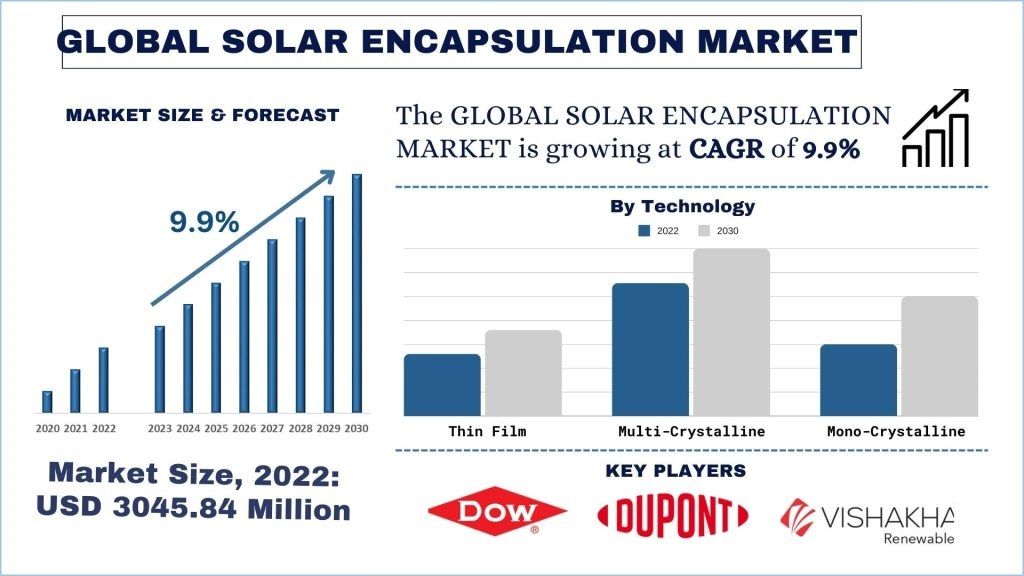
Global Solar Encapsulation Market is expected to grow at a significant rate of around 9.9% during the forecast period. Factors such as the increasing global energy demand, depletion of onshore and shallow-water reserves, innovative technologies, such as advanced drilling rigs, subsea production systems, and enhanced oil recovery techniques, high oil and gas prices, economic diversification, supportive government policies, and transition towards renewable energy are some of the factors driving the global Solar Encapsulation market.
the US Energy Information Administration (EIA) reports that as of July 2022, 98.8 million barrels per day (b/d) of petroleum and liquid fuels were consumed globally, representing a 0.9 million b/d increase from July 2021. Additionally, the average daily output of oil and liquid fuels worldwide in 2022 is expected to be approximately 99.4 million barrels, up 2.1 million from 2021.
First Solar Inc., H.B. Fuller Company, Dow Inc., Dupont, Mitsui Chemicals, 3M, JA Solar Technology Co., Renewsys India Pvt Ltd, Exxon Mobil Corporation, and Vishakha Renewables Pvt. Ltd. are some of the key players in the market. These players have undertaken several M&As along with partnerships to facilitate customers with hi-tech and innovative products/technologies.
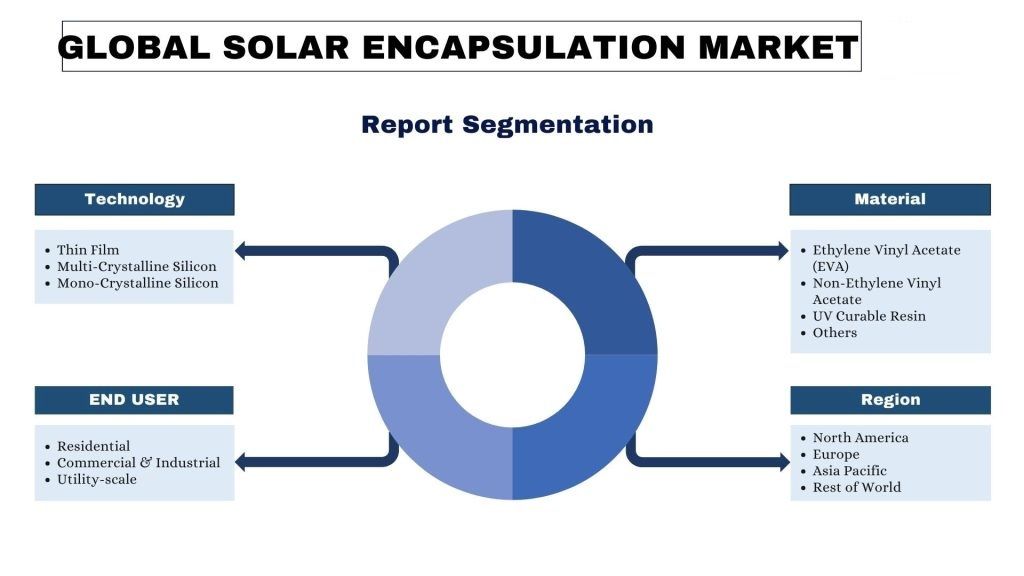
Insights Presented in the Report
“Amongst Technology, Drillship category to witness higher CAGR during the forecast period.”
Based on Technology the market is divided into Thin Film, Multi-Crystalline Silicon, and Mono-Crystalline silicon based. The monocrystalline segment dominated the market in 2022 and is expected to show the same fashion in the forecast period. The shift to more efficient monocrystalline solar PV accelerated in 2021, with the technology capturing almost all crystalline PV production. Monocrystalline panels are relatively more energy efficient and heat resistant, but at the same time, they are more expensive and leave a high carbon footprint while manufacturing. On the other hand, Mult-crystalline panels are more affordable but offer lower energy efficiency. Monocrystalline solar panels are prepared from a single, high-priority silicon crystal. These panels have gained significant popularity recently as they offer higher efficiency, heat resistance, and power production. Further, these panels have a longer life cycle and usually last longer than their expiry. These panels offer the highest photoelectric conversion efficiency of about 18–24%, thus making it a compelling choice for commercial, residential, and industrial installations. All the metal parts, 85% of solar wafers, and 95% of the glass used in the monocrystalline solar panels are recyclable. The demand for monocrystalline solar panel recycling will capture the largest market share, as these panels have been widely used across the globe and have had large adoptions in the past years.
For Instance, ReProSolar, in partnership with ROSI, won €4.8 million from the EU to establish a pilot recycling plant that can process 5,000 tons of panels per year by 2023. ROSI uses a chemical process for recycling crystalline silicon in Europe.
“Amongst End-User, utility-scale segment to hold a significant share in the market in 2022.”
Based on End-User, the market is bifurcated into Residential and Commercial & Utility-scale. is divided into Residential, Commercial & Industrial, and Utility-scale segments. The Utility-scale segment acquired a majority share in the Solar encapsulation market and is expected to showcase a substantial growth rate during the forecast period. Utility-scale PV remains the most competitive source of PV generation globally; however, building large-scale installations is becoming increasingly challenging in many regions of the world due to the lack of suitable sites. Moreover, Solar PV is the main choice for the private sector if they want to invest in renewable energy.
“Amongst Material, Ethylene Vinyl Acetate (EVA) segment to hold a significant share in the market in 2022.”
Based on Material, the market is bifurcated into Ethylene Vinyl Acetate (EVA), Non-Ethylene Vinyl Acetate, UV Curable Resin, and others. The Ethylene Vinyl Acetate (EVA) segment holds a significant market share in 2022 and is expected to showcase the same trend in the forecast period. This is majorly due to the early adoption and excellent protection properties even in the harsh environments of the material. However, with the prevalence of new materials, the segment market share is expected to decrease in the forecast period. The Ethylene Vinyl Acetate (EVA) segment is dominant in the global solar encapsulation market, driving its widespread adoption. EVA encapsulants have been the industry standard for decades, offering a range of advantages that make them an attractive choice for solar module manufacturers. EVA encapsulants provide excellent optical transparency, allowing maximum light transmission to the solar cells and thereby enhancing energy generation efficiency. Additionally, they offer superior adhesion properties, ensuring a secure bond between the solar cells and the module components and preventing delamination and moisture ingress.
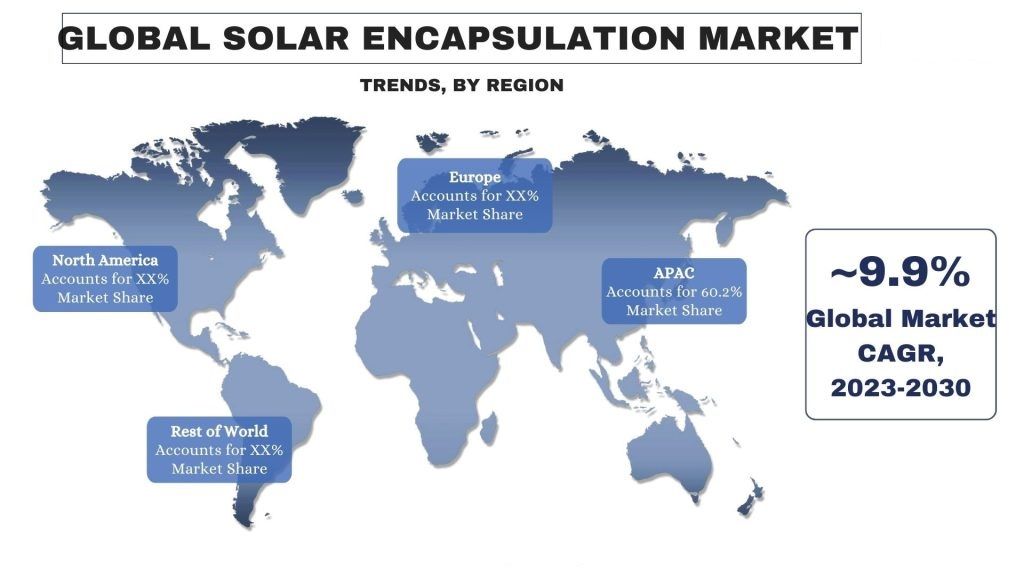
“Asia Pacific to hold a considerable share in the market.”
APAC registered the highest market share in the Solar Encapsulation and is expected to witness an influential CAGR in the forecasted period. It is mainly owing to many Solar Photovoltaic (PV) Cell projects taking place in China, India, Australia, and Japan. Moreover, favorable government policies, regulations, and investments in achieving renewable energy targets set by various countries are driving the market.
For instance: In Australia, the Australian government will provide AUD 14 million to support 5B’s AUD 33.4 million strategic technology innovation project through the Australian Renewable Energy Agency; In Japan, the Japanese government allocated 8 billion yen in the 2021 national budget to support the introduction of independent solar power generation equipment and storage batteries including electric vehicles through on-site PPA; and in India, the Government of India announced an additional capital infusion of Rs. 10 billion to the Solar Energy Corporation of India and Rs.15 billion to the Indian Renewable Energy Development Agency.
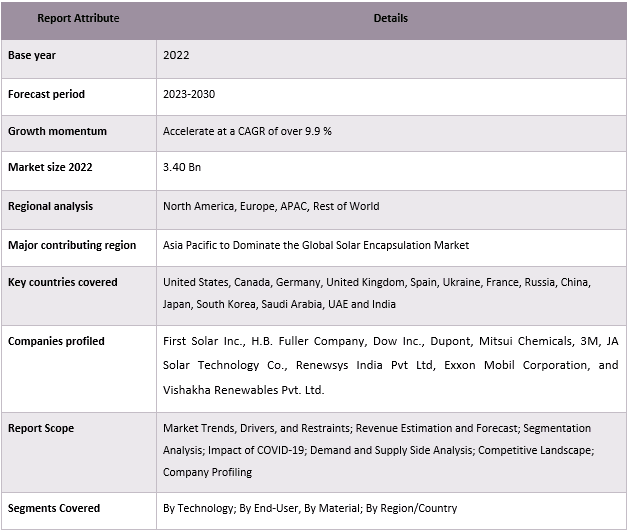
Reasons to buy this report:
- The study includes market sizing and forecasting analysis validated by authenticated key industry experts.
- The report presents a quick review of overall industry performance at one glance.
- The report covers an in-depth analysis of prominent industry peers with a primary focus on key business financials, product portfolio, expansion strategies, and recent developments.
- Detailed examination of drivers, restraints, key trends, and opportunities prevailing in the industry.
- The study comprehensively covers the market across different segments.
- Deep dive regional level analysis of the industry.
Customization Options:
The global Solar Encapsulation Market can further be customized as per the requirement or any other market segment. Besides this, UMI understands that you may have your own business needs, hence feel free to connect with us to get a report that completely suits your requirements.
Table of Contents
Research Methodology for the Solar Encapsulation Market Analysis (2023-2030)
Analyzing the historical market, estimating the current market, and forecasting the future market of the global Solar Encapsulation Market were the three major steps undertaken to create and analyze the increasing prevalence and current scenario in major regions globally. Exhaustive secondary research was conducted to collect the historical market numbers and estimate the current market size. Secondly, to validate these insights, numerous findings and assumptions were taken into consideration. Moreover, exhaustive primary interviews were also conducted, with industry experts across the value chain of the global Solar Encapsulation Market. Post assumption and validation of market numbers through primary interviews, we employed a top-down/bottom-up approach to forecasting the complete market size. Thereafter, market breakdown and data triangulation methods were adopted to estimate and analyze the market size of segments and sub-segments of the industry pertains to. Detailed methodology is explained below:
Analysis of Historical Market Size
Step 1: In-Depth Study of Secondary Sources:
Detail secondary study was conducted to obtain the historical market size of the Solar Encapsulation Market through company internal sources such as annual reports & financial statements, performance presentations, press releases, etc., and external sources including journals, news & articles, government publications, competitor publications, sector reports, third-party database, and other credible publications.
Step 2: Market Segmentation:
After obtaining the historical market size of the Solar Encapsulation Market, we conducted a detailed secondary analysis to gather historical market insights and share for different segments & sub-segments for major regions. Major segments are included in the report as Technology, End-Use, and Material. Further country-level analyses were conducted to evaluate the overall adoption of testing models in that region.
Step 3: Factor Analysis:
After acquiring the historical market size of different segments and sub-segments, we conducted a detailed factor analysis to estimate the current market size of the Solar Encapsulation Market. Further, we conducted factor analysis using dependent and independent variables such as Technology, End-User and Material of Solar Encapsulation. A thorough analysis was conducted of demand and supply-side scenarios considering top partnerships, mergers and acquisitions, business expansion, and product launches in the Solar Encapsulation Market sector across the globe.
Current Market Size Estimate & Forecast
Current Market Sizing: Based on actionable insights from the above 3 steps, we arrived at the current market size, key players in the global Solar Encapsulation Market, and market shares of the segments. All the required percentage shares split, and market breakdowns were determined using the above-mentioned secondary approach and were verified through primary interviews.
Estimation & Forecasting: For market estimation and forecast, weights were assigned to different factors including drivers & trends, restraints, and opportunities available for the stakeholders. After analyzing these factors, relevant forecasting techniques i.e., the top-down/bottom-up approach were applied to arrive at the market forecast for 2028 for different segments and sub-segments across the major markets globally. The research methodology adopted to estimate the market size encompasses:
- The industry’s market size, in terms of revenue (USD) and the adoption rate of the Solar Encapsulation Market across the major markets domestically
- All percentage shares, splits, and breakdowns of market segments and sub-segments
- Key players in the global Solar Encapsulation Market in terms of products offered. Also, the growth strategies adopted by these players to compete in the fast-growing market.
Market Size and Share Validation
Primary Research: In-depth interviews were conducted with the Key Opinion Leaders (KOLs) including Top Level Executives (CXO/VPs, Sales Head, Marketing Head, Operational Head, Regional Head, Country Head, etc.) across major regions. Primary research findings were then summarized, and statistical analysis was performed to prove the stated hypothesis. Inputs from primary research were consolidated with secondary findings, hence turning information into actionable insights.
Split of Primary Participants in Different Regions
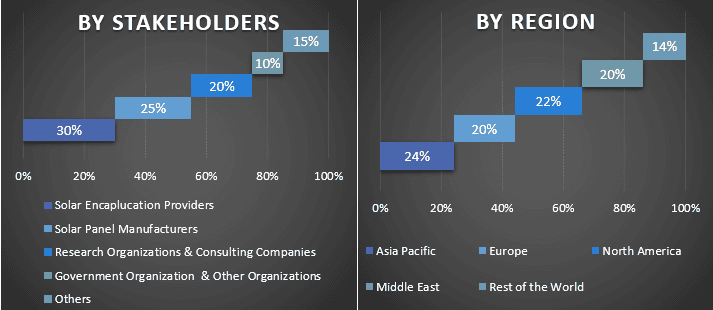
Market Engineering
The data triangulation technique was employed to complete the overall market estimation and to arrive at precise statistical numbers for each segment and sub-segment of the global Solar Encapsulation Market. Data was split into several segments & sub-segments post studying various parameters and trends in the areas of type and process in the global Solar Encapsulation Market.
The main objective of the Global Solar Encapsulation Market Study
The current & future market trends of the global Solar Encapsulation Market were pinpointed in the study. Investors can gain strategic insights to base their discretion for investments on the qualitative and quantitative analysis performed in the study. Current and future market trends determined the overall attractiveness of the market at a regional level, providing a platform for the industrial participant to exploit the untapped market to benefit from a first-mover advantage. Other quantitative goals of the studies include:
- Analyze the current and forecast market size of the Solar Encapsulation Market in terms of value (USD). Also, analyze the current and forecast market size of different segments and sub-segments.
- Segments in the study include areas of technology, end-user, and material.
- Define and analysis of the regulatory framework for the Solar Encapsulation industry.
- Analyze the value chain involved with the presence of various intermediaries, along with analyzing customer and competitor behaviors of the industry.
- Analyze the current and forecast market size of the Solar Encapsulation Market for the major region.
- Major countries of regions studied in the report include Asia Pacific, Europe, North America, Middle East, and the Rest of the World.
- Company profiles of the Solar Encapsulation Market and the growth strategies adopted by the market players to sustain in the fast-growing market.
- Deep dive regional level analysis of the industry
Frequently Asked Questions FAQs
Q1: What is the current market size and growth potential of the global Solar Encapsulation Market?
Q2: What are the driving factors for the growth of the global Solar Encapsulation Market?
Q3: Which segment has the largest share of the global Solar Encapsulation Market by Technology?
Q4: What are the emerging technologies and trends in the global Solar Encapsulation Market?
Q5: Which region will dominate the global Solar Encapsulation Market?
Q6: Who are the key players operating in the global Solar Power Recycling market?
Related Reports
Customers who bought this item also bought

